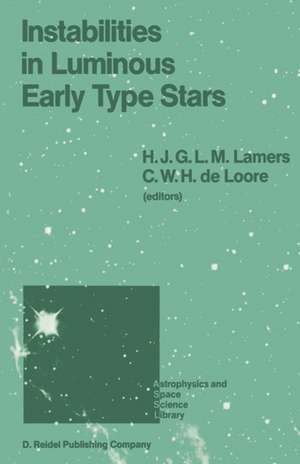Instabilities in Luminous Early Type Stars: Proceedings of a Workshop in Honour of Professor Cees De Jager on the Occasion of his 65th Birthday held in Lunteren, The Netherlands, 21–24 April 1986: Astrophysics and Space Science Library, cartea 136
Editat de Henny J.G.L.M. Lamers, C. de Looreen Limba Engleză Paperback – 12 oct 2011
Din seria Astrophysics and Space Science Library
- 24%
 Preț: 799.08 lei
Preț: 799.08 lei - 15%
 Preț: 647.92 lei
Preț: 647.92 lei - 18%
 Preț: 983.81 lei
Preț: 983.81 lei - 18%
 Preț: 790.28 lei
Preț: 790.28 lei -
 Preț: 359.85 lei
Preț: 359.85 lei -
 Preț: 389.70 lei
Preț: 389.70 lei - 20%
 Preț: 691.13 lei
Preț: 691.13 lei - 20%
 Preț: 816.17 lei
Preț: 816.17 lei - 18%
 Preț: 1011.27 lei
Preț: 1011.27 lei -
 Preț: 402.56 lei
Preț: 402.56 lei - 15%
 Preț: 664.93 lei
Preț: 664.93 lei -
 Preț: 398.15 lei
Preț: 398.15 lei - 18%
 Preț: 954.77 lei
Preț: 954.77 lei -
 Preț: 411.04 lei
Preț: 411.04 lei - 18%
 Preț: 1225.31 lei
Preț: 1225.31 lei - 18%
 Preț: 1843.29 lei
Preț: 1843.29 lei -
 Preț: 393.13 lei
Preț: 393.13 lei -
 Preț: 400.26 lei
Preț: 400.26 lei - 18%
 Preț: 953.82 lei
Preț: 953.82 lei - 18%
 Preț: 960.61 lei
Preț: 960.61 lei -
 Preț: 398.35 lei
Preț: 398.35 lei -
 Preț: 390.84 lei
Preț: 390.84 lei -
 Preț: 413.76 lei
Preț: 413.76 lei -
 Preț: 416.64 lei
Preț: 416.64 lei - 18%
 Preț: 947.67 lei
Preț: 947.67 lei -
 Preț: 404.51 lei
Preț: 404.51 lei - 18%
 Preț: 956.50 lei
Preț: 956.50 lei -
 Preț: 403.75 lei
Preț: 403.75 lei - 18%
 Preț: 1229.40 lei
Preț: 1229.40 lei - 18%
 Preț: 1224.99 lei
Preț: 1224.99 lei -
 Preț: 404.29 lei
Preț: 404.29 lei - 15%
 Preț: 654.77 lei
Preț: 654.77 lei - 18%
 Preț: 1248.20 lei
Preț: 1248.20 lei - 18%
 Preț: 955.25 lei
Preț: 955.25 lei - 18%
 Preț: 1846.28 lei
Preț: 1846.28 lei - 18%
 Preț: 1233.06 lei
Preț: 1233.06 lei - 18%
 Preț: 1234.77 lei
Preț: 1234.77 lei
Preț: 393.52 lei
Nou
Puncte Express: 590
Preț estimativ în valută:
75.30€ • 78.78$ • 62.55£
75.30€ • 78.78$ • 62.55£
Carte tipărită la comandă
Livrare economică 02-16 aprilie
Preluare comenzi: 021 569.72.76
Specificații
ISBN-13: 9789401082327
ISBN-10: 9401082324
Pagini: 312
Ilustrații: XVI, 290 p.
Dimensiuni: 178 x 254 x 16 mm
Greutate: 0.54 kg
Ediția:Softcover reprint of the original 1st ed. 1987
Editura: SPRINGER NETHERLANDS
Colecția Springer
Seria Astrophysics and Space Science Library
Locul publicării:Dordrecht, Netherlands
ISBN-10: 9401082324
Pagini: 312
Ilustrații: XVI, 290 p.
Dimensiuni: 178 x 254 x 16 mm
Greutate: 0.54 kg
Ediția:Softcover reprint of the original 1st ed. 1987
Editura: SPRINGER NETHERLANDS
Colecția Springer
Seria Astrophysics and Space Science Library
Locul publicării:Dordrecht, Netherlands
Public țintă
ResearchCuprins
Section I: Invited Reviews and General Discussions.- The upper HR diagram - An observational overview.- Observations and interpretations of stellar pulsations.- Theory of non-radial pulsations in massive early-type stars.- Theory of vibrational instabilities in luminous early type stars.- Observed variations in O and Of stars.- Observed variations in Wolf-Rayet stars.- Variations in luminous blue variables.- Giant outbursts of the Eta Carinae - P Cygni type.- Instabilities due to convection and rotation.- Shock waves in luminous early-type stars.- Radiation driven instabilities.- Stellar instabilities in the upper part of the Hertzsprung-Russell Diagram.- Section II: Poster Papers.- Massive stars in nearby galaxies.- Rate of mass-loss in the Hertzsprung-Russell Diagram.- The unstable of 06.5f?p star HD 148937 and its interstellar environment.- Two comments of the Beta Cephei variable 12 Lacertae.- Non radially pulsating Wolf-Rayet stars.- Sobolev type line profile in case of non radial wind density perturbations.- Episodic distortion and dust formation in the wind of WR140.- Photometric variability of Wolf-Rayet stars.- Improved mass loss rates for WC7-9 stars: their effect on the Wolf-Rayet stellar wind momentum problem.- Variability of Wolf-Rayet stars in linear polarization.- An extended nebulosity surrounding the S Dor variable R127.- The LMC-S Dor variable R 71 - an IRAS point source.- Eclipse spectrum of the LMC P Cyg star R 81.- The light- and colour variation of Eta Carinae for the years 1983–1986 in the VBLUW system.- Do superluminous stars really explode?.- Radiation pressure in acoustic wave calculations of early type stars.- The influence of photospheric turbulence on stellar mass loss.- Nonlinear dynamics of instabilities in line-driven stellar winds.-The X-ray emission of Tau Sco, Bo V, and the problems posed for embedded shock models.- Name index.- Object index.
Recenzii
` The format is excellent: eleven fine reviews are each followed by full discussions, while de Jager's incisive summary concludes the main section...
Why not get a copy for your libary and see how much progress has been made - and get some good ideas for further research. '
The Observatory, Vol.108.
Why not get a copy for your libary and see how much progress has been made - and get some good ideas for further research. '
The Observatory, Vol.108.














